When it comes to BBQ, beef brisket is king! What barbecue aficionados won’t tell you is that making an amazing fork-tender oven-baked brisket with a flavorful, crunchy bark is easier than you think. No smoker or grill is necessary.
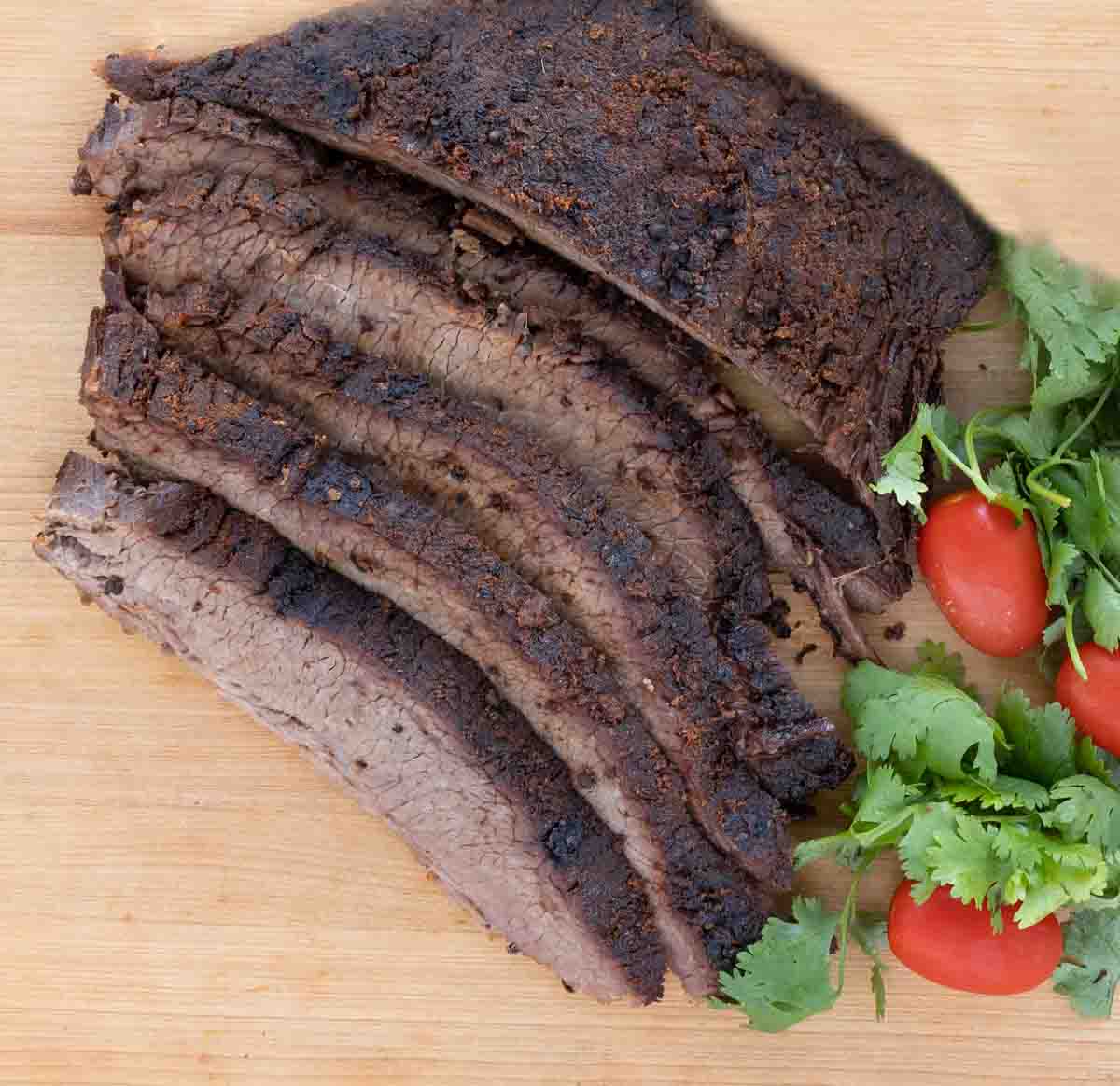
Audio Player
I love barbecue, and for years, I was afraid of making pulled pork, baby back ribs, and beef brisket in my oven. I just didn’t think they would be any good. Well, let me tell you. I couldn’t have been more wrong. Those cuts of meat come out perfectly in the oven.
But at the suggestion of a grill master friend, I learned the secrets of dry brining and slow-roasting meats in my oven. Of course, if you prefer, you can use a smoker. Try my smoked beef brisket recipe.
You can also use a slow cooker with my Slow Cooker Beef Brisket Recipe.
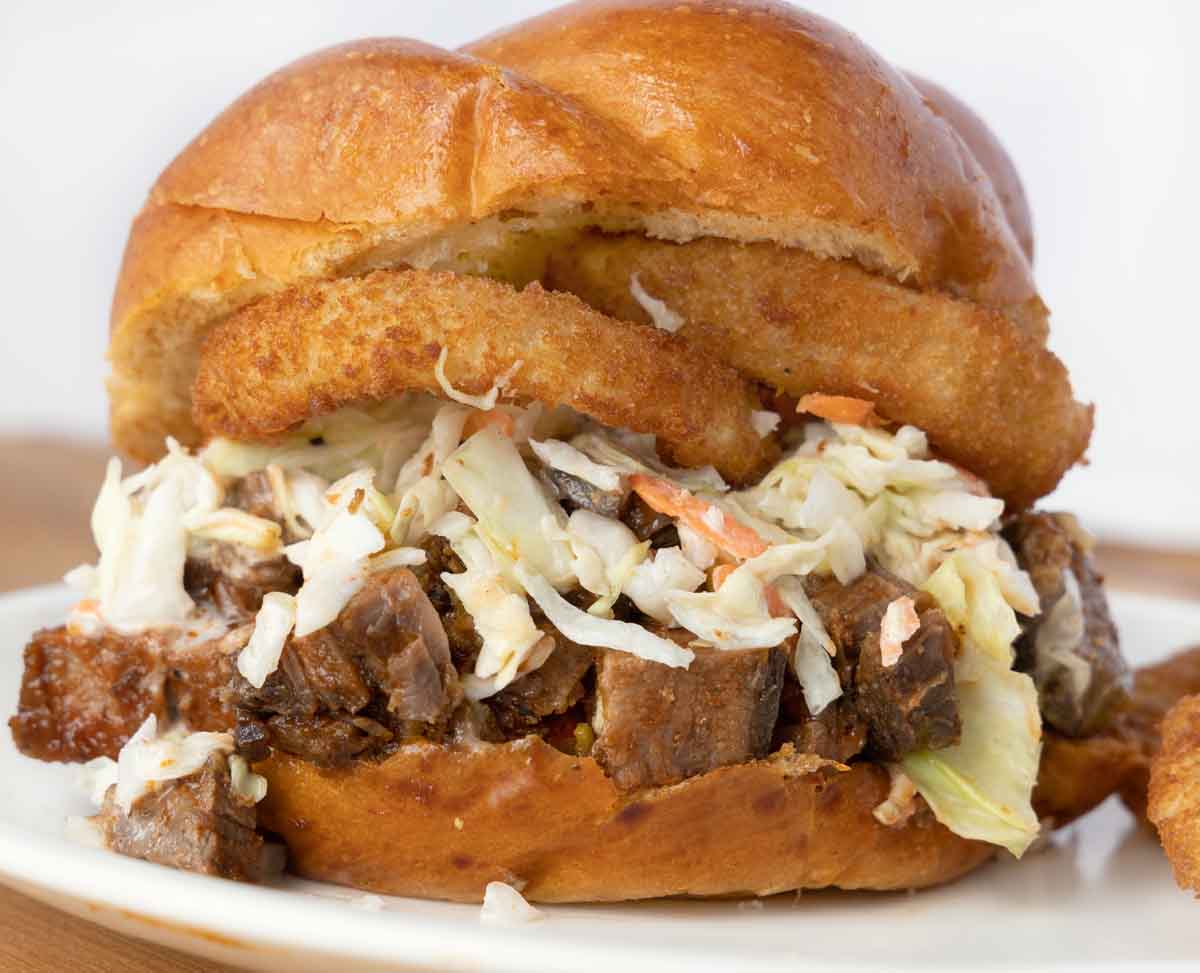
I love a good beef brisket sandwich, and one of the places I frequent for barbecue makes a delicious combination by adding coleslaw and onion rings to chopped brisket. It’s covered in BBQ sauce and served on a toasted brioche bun. Can you say heaven on a plate?
Ingredients
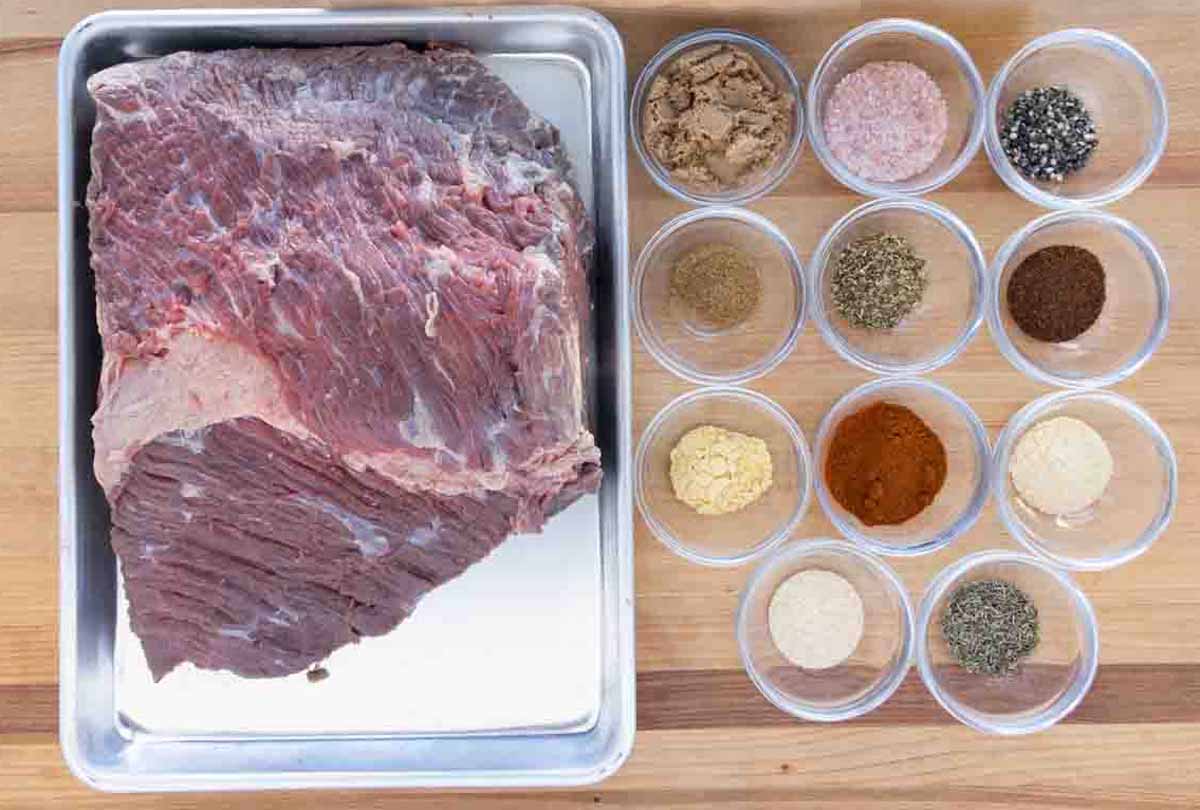
Gather the ingredients to prepare our baked beef brisket recipe. Culinary professionals call this the “Mise en Place,” which means “everything in its Place.”
Setting up your ingredients not only helps speed up the cooking process but also ensures you have all the necessary ingredients on hand to make the recipe.
What are the different cuts of Beef Brisket?
Beef brisket is available in three different cuts. A full-packer brisket is a whole brisket that includes both the point and flat sections. It weighs 8 to 12 pounds.
The point cut is the fatty part of the brisket, also known as the deckle or second cut. The flat cut is the leaner cut of the brisket, also known as the first cut.
Whether you use the whole brisket, a flat, or the point, this recipe will still yield a moist, tender, OMG flavorful oven baked brisket.
*For my oven-roasted beef brisket recipe, either the flat or the point will work. Most grocery stores will carry the flat.
How to Make Oven-Baked Brisket
Follow along with my simple step-by-step instructions to learn how to make oven-baked brisket in your home kitchen.
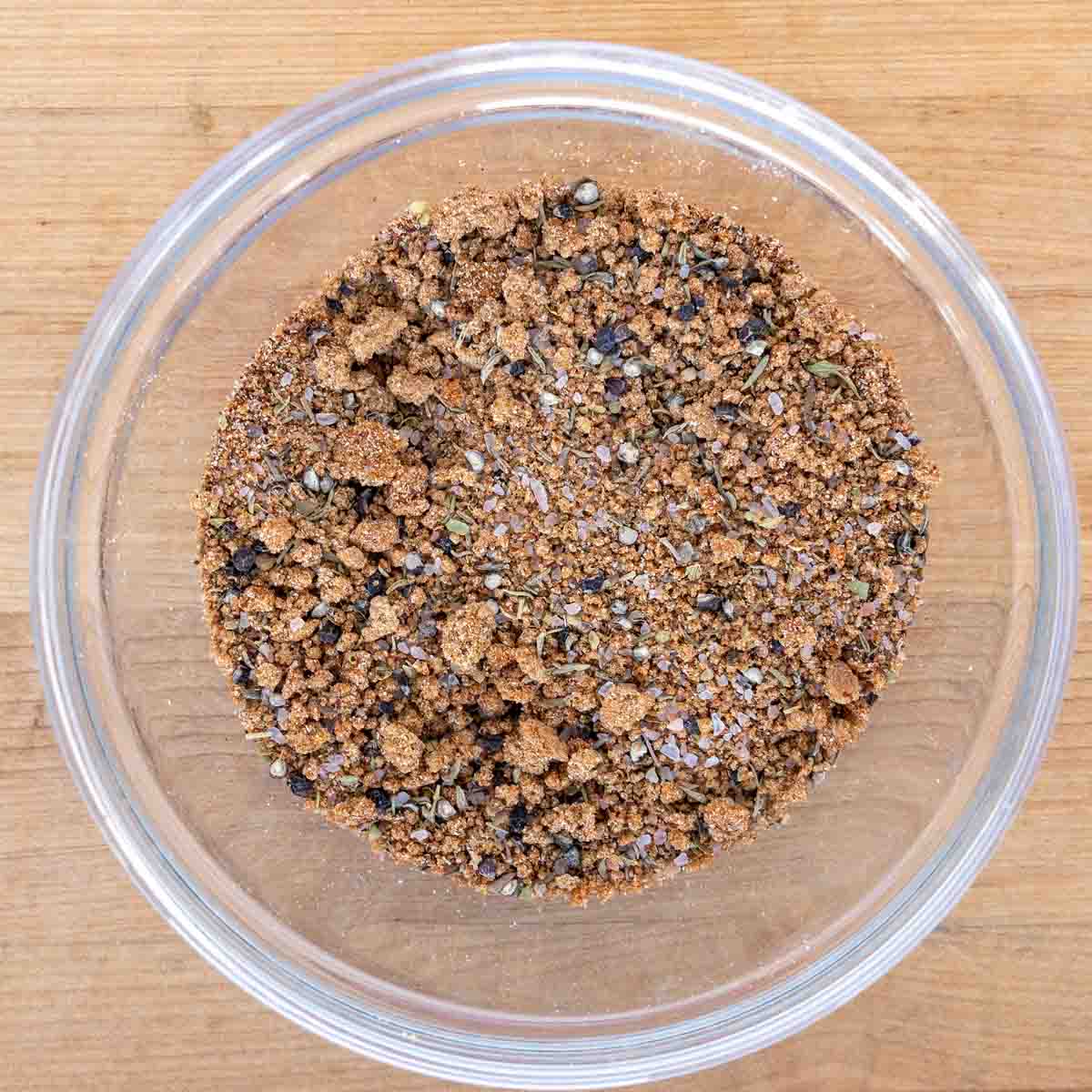
The first step is preparing the beef brisket rub. This will act as a brine, adding flavor and helping to keep it moist.
*My spices include onion powder, garlic powder, brown sugar, chili powder, sea salt, cracked black pepper, and a few others. Feel free to adjust the seasonings to your taste.
Start by trimming the brisket of any silver skin, and if needed, removing most of the fat cap from the top of the meat. Hard fat does not render!
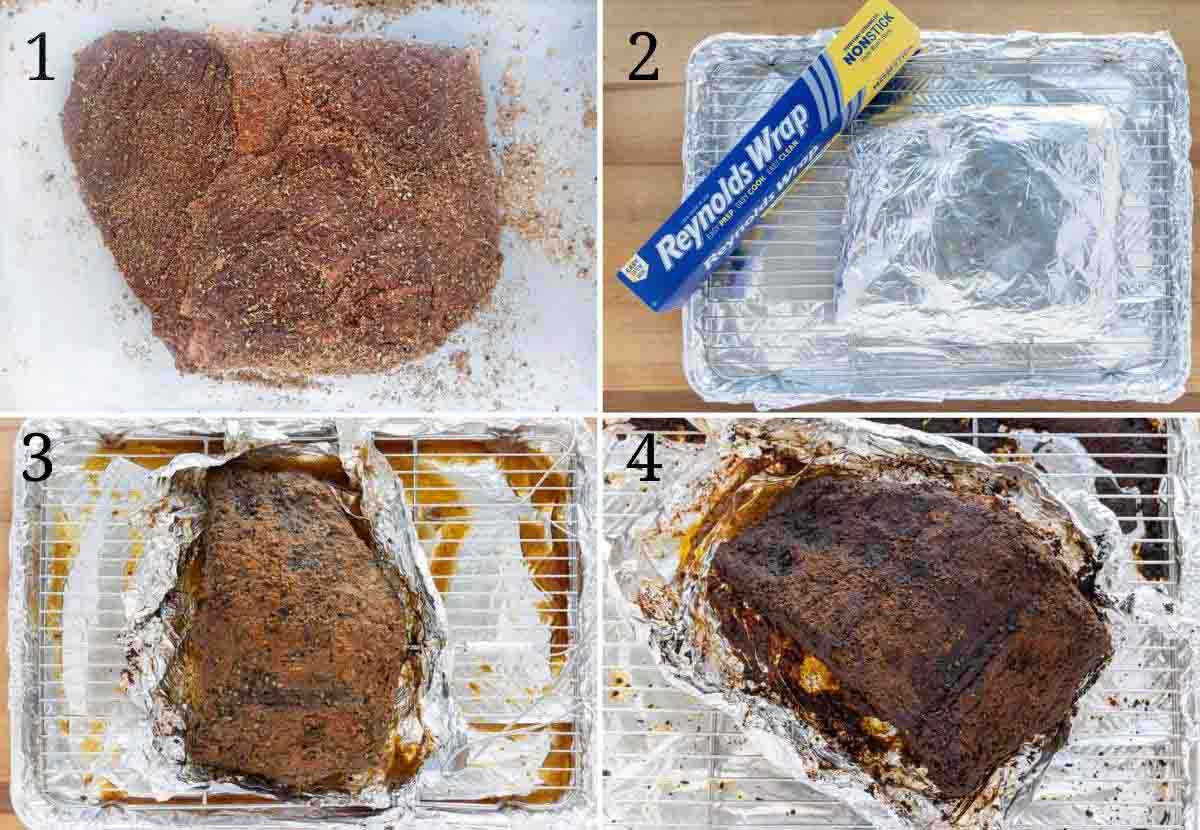
- Pat the meat dry with paper towels and coat it with the brisket rub, massaging the dry rub into the meat, making sure to coat the sides of the brisket.
- Wrap the dry-rubbed brisket tightly with foil and refrigerate overnight. *The beef brisket rub must penetrate the beef for at least 3 hours.
- Take the dry-rubbed brisket out of the refrigerator an hour before cooking, allowing it to come to room temperature.
- Preheat the oven to 275°F.
- Insert an oven-safe meat thermometer into the thickest part of the beef. The fat side should be up during the roasting process.
- Slow Roast in the oven until the internal temperature reaches 175 degrees F.
- Remove the brisket from the oven, and carefully cut the foil open to expose it. Continue roasting until the internal temperature reaches 195-205 degrees F.
Chef Dennis Tip:
Do not be tempted to raise the temperature for faster cooking time, or your brisket will be very tough. Slow oven roasting using a low temperature allows the fats to break down gradually, tenderizing the beef while keeping it juicy.
How do I slice oven-baked brisket?
Place the beef brisket on a cutting board and let it rest for an hour before slicing. Slices should be pencil-width thick.
Allowing the beef to rest gives the juices time to redistribute throughout the meat. If sliced right off the grill, the meat would lose moisture.
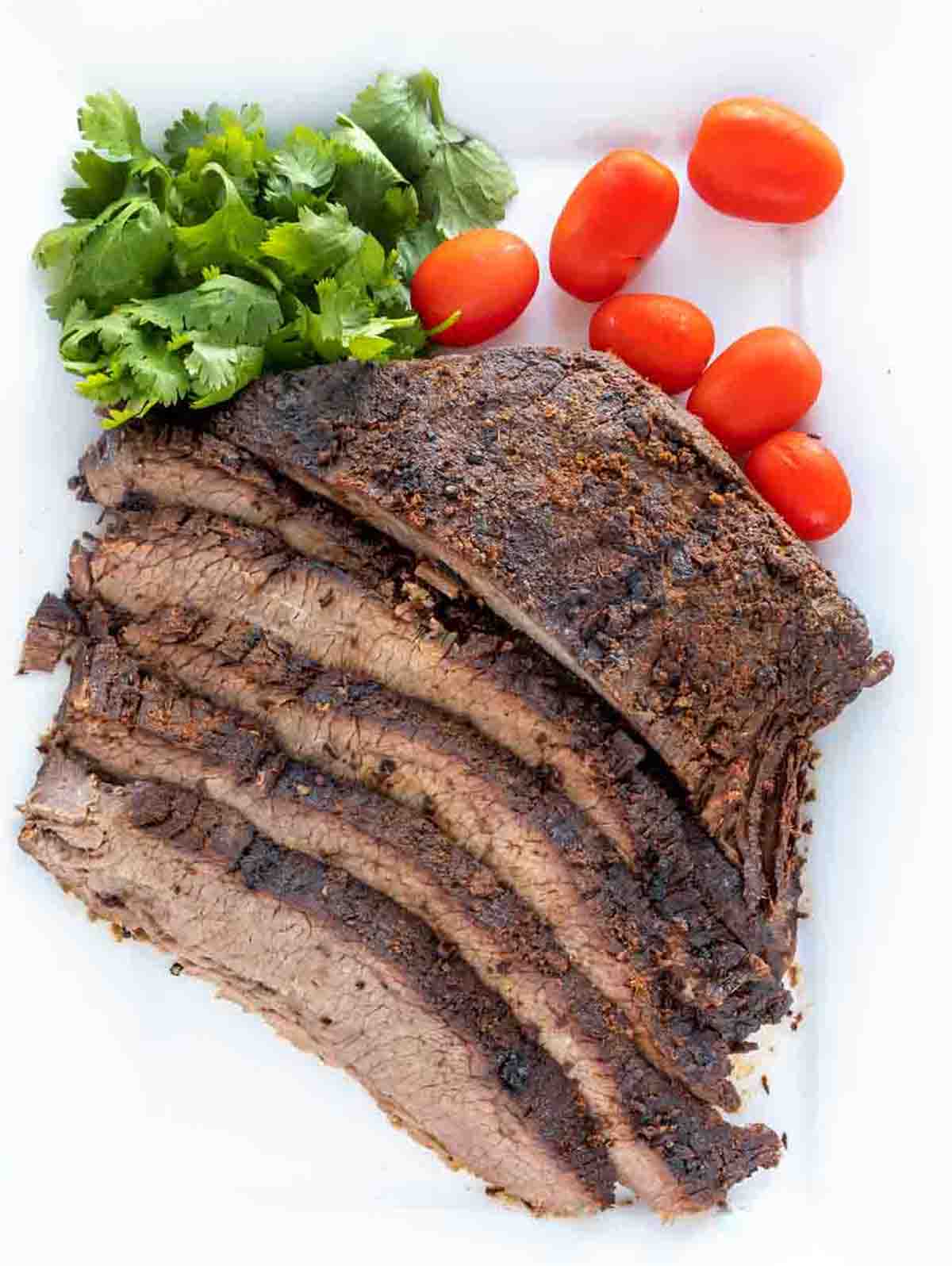
After the brisket has rested, the next step is finding the grain. The direction of the cut is key to having tender, fall-apart slices of brisket.
You want to slice against the grain. The grain of any meat is the alignment of the muscle fibers. When you cut with the grain, the muscle fibers remain somewhat intact and result in meat that is tough and difficult to chew. When you cut against the grain, you break up the muscle fibers evenly so that the meat becomes much more tender and easy to chew.
Chef Dennis Tip:
Before cooking, find the grain and slice a corner of the flat. This will make it easier to find the direction of the grain when the brisket is done and ready to be sliced.
How can I use leftover baked beef brisket?
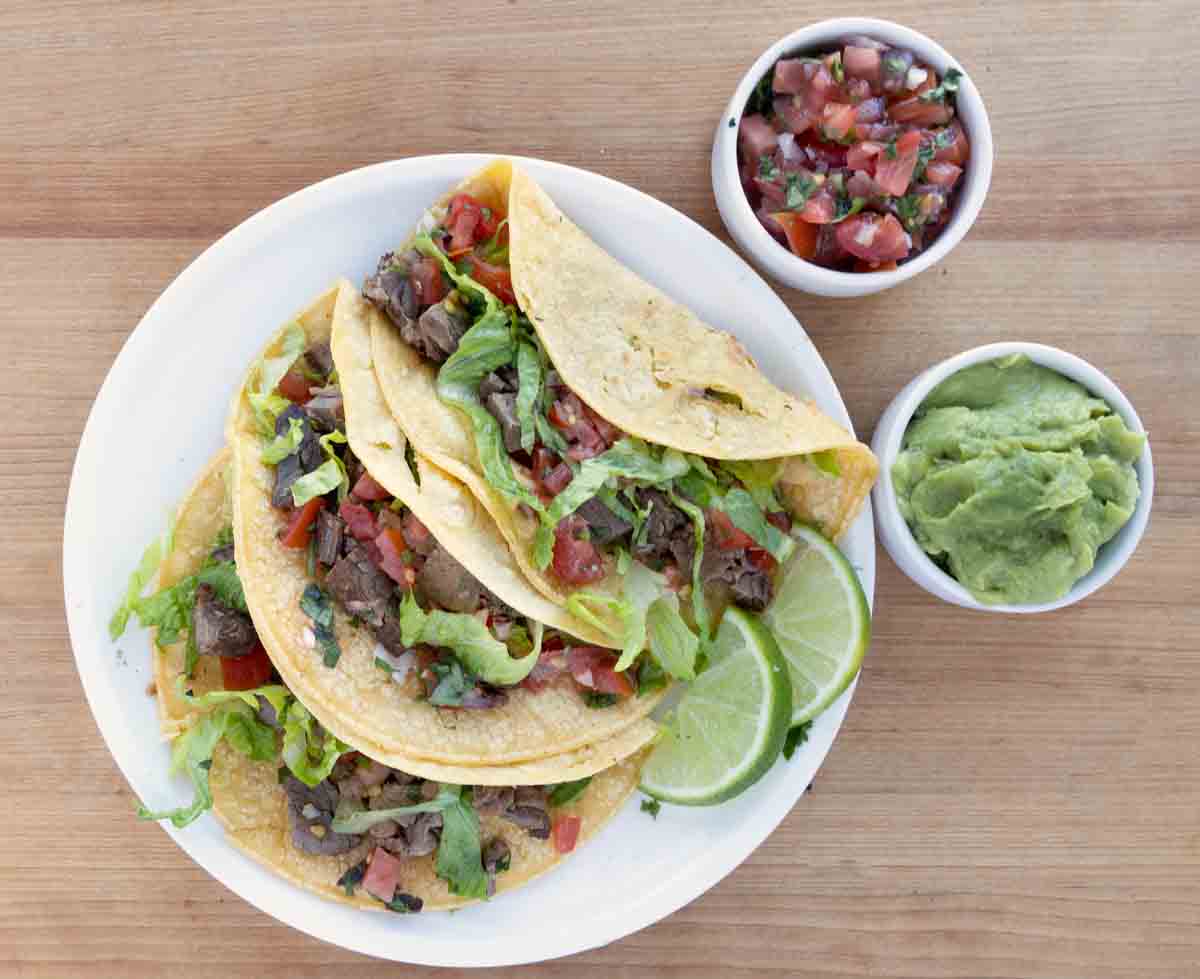
You’ll often find chopped brisket in tacos, sandwiches, and chili. Other delicious uses for leftover brisket are brisket hash, soups, stews, quesadillas, pizza toppings, and brisket and beans, to name a few.
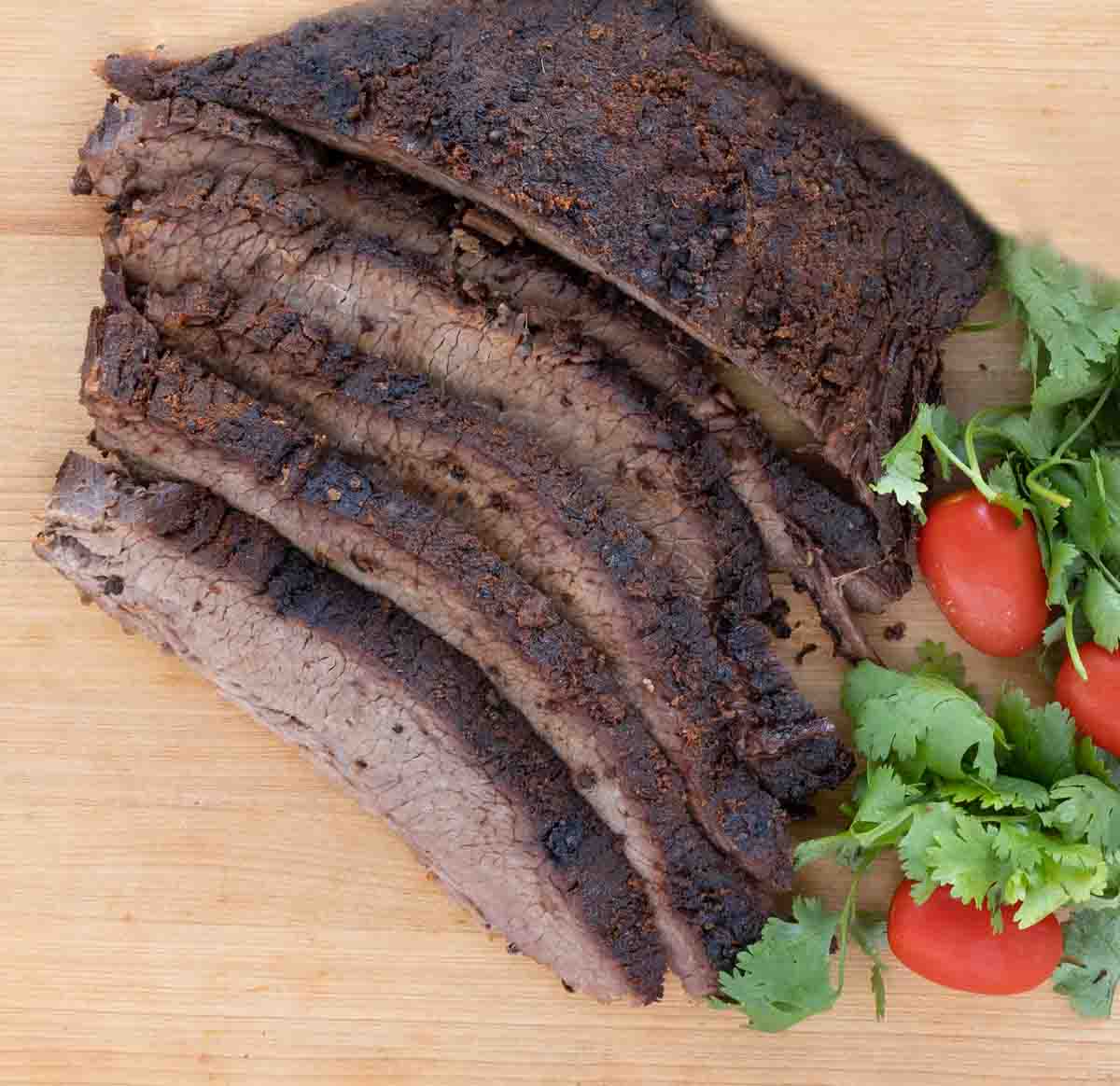
Wouldn’t your friends and family love to sit down to this tender, delicious baked beef brisket?
Why not surprise them and let them think you’re the new grill master in the family? I won’t tell them you made it in the oven!
Storing and Reheating
Any leftovers should be stored refrigerated in an airtight container or well covered in plastic wrap for 3-4 days.
To reheat, preheat your oven to 325°F. Place the brisket in a baking pan. Pour about one cup of beef broth over the brisket. Then cover tightly with aluminum foil, creating a double layer.
Place the pan in the oven and reheat for about 45 minutes or until the internal temperature reaches 165°F. Let the meat rest for 10-15 minutes before slicing.
Recipe FAQ’s
If you rub the brisket with the spice mixture and immediately place it in the oven, it’s just a rub. It will flavor the exterior of the meat, and the spices will penetrate a little way into the beef.
But if you rub the seasonings into the brisket and let it sit overnight before roasting, this would be considered a brisket dry brine. The salt and other seasonings will have time to truly work their way into the center of the beef, giving you a more flavorful piece of meat.
Brisket is a tougher cut of meat, which means it needs to be slow-roasted to a higher internal temperature before the fats start to break down and tenderize the meat. The magic starts to happen at 195 degrees and can continue to cook until 205 degrees.
A good rule of thumb is to cook the brisket for 60 minutes per pound at 275 degrees F. Of course, this all depends on your oven. Make sure to give yourself extra time just in case it hasn’t reached the optimal internal temperature range of 195 -205 degrees F.
To get a fork-tender brisket, the maximum cooking temperature is 300 degrees F. Any hotter will produce a tough brisket. Brisket needs a slow roast, and the sweet spot for roasting is 250-275 degrees F.
More Recipes You’ll Love!
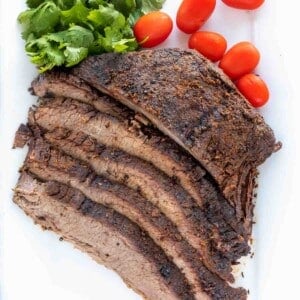
Dry Rub Oven Baked Brisket
Ingredients
- 5 lb beef brisket
- ¼ cup brown sugar
- 2 tablespoon coarse sea salt kosher salt can be substituted. *If you use table salt cut it down to 1 tbsp.
- 1 tablespoon cracked black pepper more if you like black pepper as much as I do.
- 1 tablespoon garlic powder
- 1 tablespoon onion powder
- 1 tablespoon chili powder
- 1 tablespoon smoked paprika or sweet paprika
- 1 teaspoon dried mustard
- 1 teaspoon dried thyme
Instructions
- Mix dry rub ingredients. (This recipe for dry rub will cover a 5 lb brisket.)
- Remove the brisket from the package and trim away any silver skin or excess fat.
- Coat the entire brisket with the dry rub and massage the dry rub into the meat. Make sure to coat the sides of the brisket.
- Wrap the dry-rubbed brisket tightly with non-stick aluminum foil and refrigerate overnight. Completely wrap it as a package in one direction then go across the other direction sealing the foil.*A minimum of 3 hours is needed for the dry rub to penetrate the brisket.
- Take the brisket out of the refrigerator an hour before cooking it, allow the brisket to get to room temperature before cooking.
- Preheat the oven to 275° F
- Insert an oven-safe meat thermometer into the thickest part of the brisket
- Place the foil-wrapped brisket on a baking pan (if you have a rack place it on the baking pan and place the brisket on the rack which is on top of the pan).
- Place the baking pan on the center rack of the preheated oven and slow roast the brisket until the internal temperature reaches 175 degrees F.
- Remove the brisket from the oven and carefully cut the foil open to expose the brisket, and continue roasting until the internal temperature reaches 195-205 degrees F.*Depending on your oven and where you inserted the meat thermometer, this process may take 5-6 hours.
- Do not be tempted to raise the temperature for faster cooking time, or your brisket will be very tough. Slow oven roasting allows the fats to break down gradually, tenderizing the beef, so it has a stretching juicy quality in the end.
- Remove the brisket from the oven and place it on a cutting board. Tent the brisket with a sheet of foil, and let it rest for one hour so the juices redistribute evenly throughout the brisket.
- When cutting the brisket make sure to go against the grain. Slice the brisket in pencil width slices. *See Notes

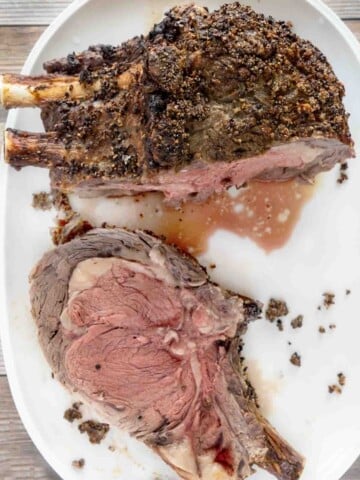
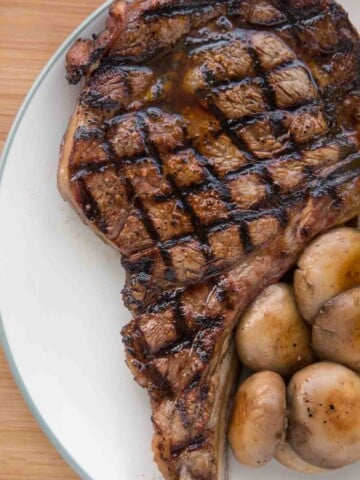
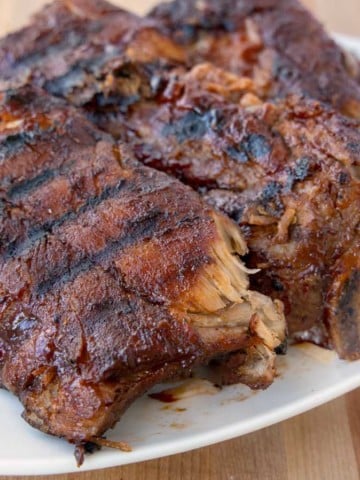
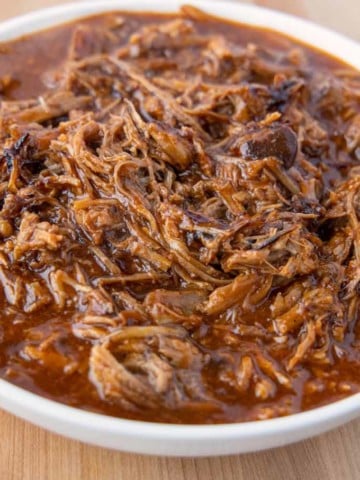
Trish says
My two 5-pound briskets were delicious and fork tender—a big hit for Christmas lunch. My only disappointment was that the drippings were very, very salty—Dead Sea salty. I had to do some major doctoring by mixing a portion of the drippings with other ingredients to have something other than BBQ sauce to drizzle. The meat, though, was perfectly seasoned and made delicious brisket sandwiches the next day. I’ll hang on to this recipe.
Jean says
How do you make a good sandwich out of this brisket?
Chef Dennis Littley says
Barbecue sauce, coleslaw and pickles has always been my favorite sandwich using brisket.
Michelle Pettitt says
Hi, have a question. Our brisket is in the oven right now, and it’s been in for three hours, and it’s reading 200° already. Do we still just keep it in and let it keep cooking so it gets juicier? Thank you!
Chef Dennis Littley says
If it’s reading 200 degrees it’s done and wont juicier the longer you leave it in. The opposite will actually occur. Just make sure its at 200 in the thickest part of the brisket.
Kathleen says
Can you cut the brisket in half so it takes less time to cook?
Chef Dennis Littley says
I would not suggest it with brisket. You really can’t rush the process or you’ll end up with a tough chewy brisket.
Annette Hazen says
Do I put my oven on bake or roast and when taking foil off do I remove it all or slightly remove around the top..
Chef Dennis Littley says
I would go with roast and as shown in the step by step pictures remove the foil entirely from the top of the brisket.
Mirsi says
Can I make this a day ahead and how would I reheat? Slice and reheat or whole?
Chef Dennis Littley says
You can make it a day ahead of time, but it will never be as good as the day you cook it. I wouldn’t slice it until your ready to serve. Place it in a baking dish with beef broth, apple juice, water or beer. Cover with foil and place it in a 325 oven for about 45 – 60 minutes or until the internal temperature reaches 165°F.
jerry says
I printed the recipe for a 10lb brisket. Cooking time is the same as the 5lb recipe, about 5.5 hours. Is that correct or the 10 lb will take longer?
Chef Dennis Littley says
It will definitely take longer. Rule of thumb is 60 minutes per pound. Make sure to use a meat thermometer to keep track of the internal temperature. You want it to reach 205 degrees.
Chery F says
This recipe looks great. Would like to try this for Christmas. How do I keep it warm without drying it out.
Chef Dennis Littley says
Add some liquid to the pan, cover with foil and keep warm in a 175 degree oven. Also place a pan with water to the oven to keep the air moist.
Sandy B says
BEST BRISKET EVER! Followed exactly. Smelled terrific the entire time it was cooking!
Chef Dennis Littley says
I’m happy to hear you enjoyed the brisket Sandy! I have delicious pulled pork and baby back ribs recipes if you’re looking for more oven baked BBQ
Lisa says
I notice the dry rub recipe ingredients are different between the recipe and the video. Which is better? thank you.
Chef Dennis Littley says
The videos are done by a company and just to give you and idea how to make the recipe, always defer to the actual recipe at the bottom of the post.
Ken says
Something is wrong with your “print” button. Won’t print
Chef Dennis Littley says
It works for me and I just had a few friends try it and they all said it works. It must be something on your end.
Mela says
Never in my life have I have never tried to cook a brisket. I don’t have a smoker and everyone seems to smoke them. I saw this recipe and I had a small brisket so I said what they heck right? I wrapped it in foil as instructed and put in fridge overnight; brought to room temp and cooked exactly how instructed. It took 4 ever to reach 175 and then I let it go a little too long to 210, so it was way done, BUT…….. oh so delicious, juicy, and tender, I mean fall apart tender, and juicy. I am no longer afraid of Brisket. Thank you. I shall look for your prime rib recipe if you have one. Thanks for posting. mmmmmm YUMMY.
Chef Dennis Littley says
I’m happy to hear you enjoyed the brisket! I know it can take longer than you thought and that’s just the way it is sometimes. It happens more often in a smoker and the meat kind of hits a wall and then very slowly increases.
I do have a prime rib recipe -> https://www.askchefdennis.com/prime-rib-roast/. and I also have an excellent, baby back ribs and Pulled Pork recipe that are both done in the oven. I have grill and smoker versions, but the oven versions are my favorite.
Michelle says
Should brisket be on a rack in pan or not
Chef Dennis Littley says
Sorry for the confusion. If you have a rack, place it on top of the rack. This will allow air to flow around the brisket, for a more evenly cooked piece of meat.
Mary Ann McLaughlin says
I am planning on making my first brisket ever this weekend. I don’t know which oven setting to use. I have three to choose from: bake, convection bake, or convection roast. For most roasted type meat (beef, chicken, pork) I use the convection roast setting. What do you think?
Chef Dennis Littley says
Convection just moves the air around helping to cook more evenly and more quickly. Either of the convection settings are fine for the brisket.
Michael says
Chef,
This is a fantastic recipe. Thanks, my first time brisket, point cut was superb. The flat is next, in your crock pot recipe.
Chef Dennis Littley says
Just a heads up to let you know, the point is the fatty part of the brisket and is very tender, the point is lean and doesn’t have the fat to add extra flavor and keep it moist. Just didn’t want you thinking you did something wrong. They are both delicious but the point is my favorite.
Red says
When I made the brisket first time ever, I looked up so many recipes that I can follow the instructions easily. It turned out so nice and I was so thrilled how I was able to make such delicious brisket ever. I am confident enough to use this recipe over and over especially when I have friends and family coming over. Thanks so much for the recipe.
Frank says
Thank you for your recipe, it saved the day. I went to check on my pellet smoker at 4AM and it had quit! Twice got it going again but it stopped so went to plan B. I guessed the smoker had been working for about 3-4 hours of the six total it should have been at that point. Found your recipe, wrapped the brisket in foil and followed it from there. Turned out really really well which was a good thing as we had 18 people for dinner!!
Chef Dennis Littley says
Sorry about your problems with your smoker Frank, but I’m happy to hear I was able to help you finish the brisket.